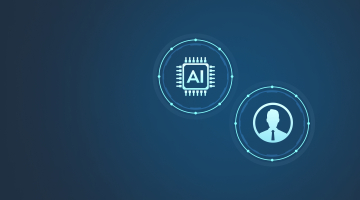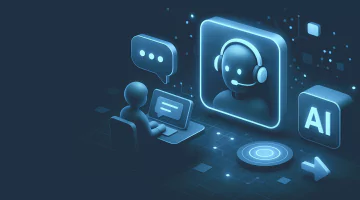

AI agents for customer service: How to implement
Maximum customer satisfaction is the name of the game in modern business, no matter what industry your organization works in. Companies go to all lengths to anticipate customer needs and ensure exclusive customer service quality in a cut-throat competition for consumers in the contemporary oversaturated commercial landscape.
Despite realizing the paramount importance of top-notch customer experiences people get while interacting with brands, many enterprises’ customer service teams fail to provide instant responses to customer queries and promptly solve customer issues. The inadequacy of companies’ efforts to forge stronger customer relationships results in significant customer churn, amounting to 65%, with $3.7 trillion in global sales at risk.
Evidently, the efficiency and work ethics of human agents fall short of consumer expectations, urging organizations to turn to specialized customer service software that can boost agent efficiency and increase the productivity of customer service team members. Disruptive AI systems set the pace among numerous IT products, enabling support teams to stay ahead of the technological curve and revolutionize their workflows.
This article will introduce the notion of AI agents, explore the use cases of AI-powered customer service solutions, list the types of customer service AI agents, and outline a roadmap for building a robust AI agent for customer service.
Read our related article: How to build AI agents
Meet an AI agent
The present-day market of professional digital products is full of highly useful solutions that cater to a wide gamut of business needs, helping organizations across various verticals streamline and facilitate their operations. The advent of artificial intelligence and related know-how (machine learning, natural language processing, computer vision, large language models, and others) elevated enterprise software to higher standards, allowing personnel to entrust more sophisticated and complex tasks to disruptive AI tools.
AI agents are one of such state-of-the-art products. AI technology is a second-to-none mechanism capable of acting autonomously in various business settings, automating routine tasks, analyzing diverse data across large knowledge bases, making informed decisions, and executing them. How can they excel at such high-level jobs without human assistance? The answer can be found in the underlying organizational principles that account for agent efficiency.
At first, an AI agent surveys the environment, registers its elements, and pinpoints changes (both historical and real-time) occurring in it. Then, it interprets the information obtained at the initial stage, comparing it against knowledge base articles, recognizing patterns, and drawing data-driven insights. The reasoning complete, the agent responds to environmental fluctuations, taking relevant actions to achieve pre-established objectives. Finally, AI algorithms perform an after-action review of a sort, considering the impact of the adopted steps on further developments and outlining potential outcome scenarios.
Two vital characteristics of AI agents make them indispensable in the dynamic business and technological world of the early 21st century. The first is their learning and adaptation ability, which allows them to sharpen their analytical and predictive skills with each new data point they ingest and process. The second is their capacity to collaborate, teaming up with other birds of a similar feather and contributing specialized expertise while solving complex tasks that require the participation of several agents with clearly defined roles.
Given the remarkable AI agent productivity and efficiency, it is no wonder that organizations involve them in multiple internal and client-facing workflows. How can leveraging AI agents improve customer service routines?
Experiencing a lack of AI expertise and skills?
Connect with a professional team to address your project challenges.
Unleashing AI in customer service: Agents’ use cases scrutinized
As vetted experts in implementing AI solutions for customer service, we at DICEUS see several ways in which they can become instrumental in providing a best-in-class customer service experience.
Use cases of AI agents
Request and inquiry handling
AI agents can tackle all customer interactions across various channels and touchpoints (like email or chat) and give immediate answers to customer questions. If providing consistent responses to customer requests turns out beyond the agent’s expertise level or requires human interaction, they can escalate urgent issues or perform intelligent routing and direct customers to qualified experts who will deal with the problem hammer and tongs.
While supplying relevant responses, AI agents go beyond just agent assistance. They analyze customer conversations and discover patterns in service inquiries to better address clients’ needs and automatically generate FAQs in line with customer feedback, thus reducing ticket volume. Another automating initiative AI agents participate in is issuing individual order status updates, which creates personalized experiences for customers.
Customer interaction management
Client-brand communication can be taken a notch higher by integrating AI-powered chatbots as pivotal elements that guarantee personalized service and customer success. They can carry on human-like conversations with the consumers, react to questions, pay attention to context, and analyze past interactions to increase the relevance of responses. Besides, such conversational AI customer service agents automatically create support chat transcripts, allowing personnel to review follow-up actions and analyze details in case the disgruntled customer launches a complaint.
Chatbot for insurance companies
Ticket generation
This is one of the mission-critical customer service interactions, and thanks to AI agents, it can be completely automated. Relying on generative AI mechanisms, the agent creates a ticket triggered by the inquiry, populates key details in its fields, categorizes it according to pre-defined NLP principles, assesses its urgency steering by the issue’s character, context, and customer sentiment, informs the client via a personalized message that the ticket has been created, and directs the ticket to appropriate departments or support agents.
Ticket resolution and closure
An AI agent doesn’t call it a day after the ticket is routed for resolution. It studies customer history and previous interactions to let support teams understand the context, suggests solutions referring clients to knowledge base content of FAQs, generates qualified responses, informs both the customer and the support team members about the ticket status, sends follow-up emails with additional resources recommendations, and issues notifications concerning the resolved ticket’s closure.
Post issue resolution
Organizations poised for a smooth customer experience should make sure their clients receive instant support and are satisfied with ticket resolution. AI agents help them achieve that by inviting consumers to share their opinions through personalized feedback requests and surveys, and encouraging them to provide testimonials.
Customer satisfaction assessment
Companies are also interested in what consumers think about their products or services. AI agents dig deep into this kind of customer feedback, too, first sending surveys, then categorizing, interpreting, and summarizing their results, pinpointing patterns in them, gauging customer sentiment across all available channels, detecting areas for improvement, and proactively suggesting support service adjustments. Moreover, the revealed trends serve as guidelines for identifying knowledge base gaps and suggesting updates, replenishments, and modifications of the information it contains.
Analytics and reporting
An AI agent’s broad speech and text analysis capabilities allow it to analyze customer behavior, historical data, and reviews, discover consumers who are about to churn, and leverage targeted retention measures. Agents can also conduct service demand analysis with an eye to staff optimization and enhanced resource allocation. Besides, they can apply versatile performance metrics to gauge ticket resolution time, trace its dynamics, measure customer satisfaction scores, and provide predictive insights concerning future trends in customer service and potential issues support teams are likely to face one day.
To get maximum value from the employment of AI agents, you should choose the right software designed to handle specific customer service workflows and tasks.
Types of AI agents in customer service
Depending on the customer service operations they are designed to tackle, AI agents fall into several classes.
Types of AI agents
Virtual assistants for customers (VCAs)
These are the most advanced agents geared to deal with complex pipeline tasks through their multiple functionalities, such as voice, chat, sentiment analysis, predictive analytics, and more. Alongside handling various queries, VCAs can automate routine tasks and issue tailored recommendations to consumers concerning different aspects of the company’s operations, its products or services, etc.
Automated follow-up agents
For organizations concerned about their business reputation, it is essential to leave no unresolved issues out of their scope of attention. To guarantee customer queries are addressed properly and people are satisfied with the result, such agents send reminders, gather feedback, and offer additional help if necessary.
Fraud detection systems
Fraudulent activities are one of the most serious threats nowadays, capable of sapping an organization’s financial resources and damaging its reliability in the public’s eye. Fraud detection agents are called to forestall such instances by monitoring transactions and interactions, tracing patterns, pinpointing anomalies, alerting support teams to suspicious developments, and instituting preventive steps aimed at customer protection.
Systems of intelligent routing
They handle customer queries, and tickets are directed to the department qualified to address them or to support channels that are convenient for the customer. In this way, they accelerate resolution speed, improve resolution accuracy, and enhance workforce coordination within the organization.
Sentiment analysis tools
Their overarching goal is to mitigate customer dissatisfaction. Such agents can gauge the emotional charge of customer interactions, expose frustration levels, and prioritize queries where annoyance or resentment is above the average for quicker resolution.
Predictive analysis agents
They study customers’ purchasing history, browsing patterns, and other relevant data symptomatic of customer behavior to forecast their potential needs. Armed with such insights, they help support teams anticipate client requirements and tailor their services accordingly.
Knowledge management systems
As an organization expands and increases its range of services or products, the knowledge base it draws upon grows exponentially. This type of AI agent assists in its efficient management by assembling and storing relevant information (product details, FAQs, troubleshooting guides, you name it), updating it regularly, and ensuring seamless access to it.
Whatever type of AI agent you need to bolster your customer service, the algorithm of their creation is pretty much similar.
How to implement an AI agent: A brief guide
The qualified and certified team of DICEUS’s experts has devised a 15-step roadmap for building AI-fueled custom products that can be slightly modified to meet specific business and technical requirements.
How to implement AI agents
Step 1. Defining the project’s objectives and scope
The first thing to do is to get to grips with the customer service field (product inquiries, technical support, complaint resolution, etc.) where your AI agent will operate and the major challenges it will be employed to address. Together with customer representatives, we finalize the list of tasks in this area, such as knowledge base management, customer interaction, sentiment analysis, ticket generation and resolution, and more.
Step 2. Selecting the model and tech stack
While choosing an appropriate AI model for building an agent, we consider two factors. Firstly, we evaluate the model’s characteristics (performance, size, licensing, etc.). Secondly, we look for a model that fits the task set for it. For example, fraud detection features can be crafted with Mets’s LLaMA, the agent’s multilingual capabilities are enabled by leveraging BLOOM or Google’s PaLM 2, whereas for providing supporting customer interactions and natural language processing, ChatGPT by OpenAI is an excellent choice.
The same is true for platforms on which we develop agents. Among the plethora of options in this realm, we prefer AutoGen by Microsoft, which offers a wide range of tools essential for building solutions that handle multi-turn conversations.
Step 3. Data collection and cleansing
We determine the sources from which relevant data can be obtained, such as support tickets, product documents, customer interaction archives, and the like. The information is retrieved from them and meticulously curated to ensure its understandability, accuracy, integrity, consistency, completeness, and compatibility with the model we plan to use.
Step 4. Model training
We train the chosen model by feeding it the pre-processed, task-specific data. By engineering prompts and phrasing questions in various ways, our experts enhance the model’s ability to interpret messages and effectively address customer queries.
Step 5. AI agent’s architecture design
A typical AI agent’s architecture consists of an input processing module (handling commands and queries by interpreting customer requests), LLM interaction (responsible for generating relevant responses and insights), an output generation unit with natural language production capabilities (presenting results clearly and understandably), and memory (containing past interactions and maintaining context during ongoing conversations). All of them should be able to communicate seamlessly with each other.
Step 6. Installing natural language understanding mechanisms
They enhance the agent’s comprehension competence, allowing the software to interpret commands and queries, infer the customer’s intent, summarize topics, compare options, recognize specific entities in texts (such as brand and product names, specialized terms), and generate responses or targeted recommendations.
Step 7. Connecting to external sources
The AI agent’s power increases manifold if it can retrieve information from as many knowledge bases as possible. To provide such interaction and data sharing, we integrate the agent with multiple platforms and data warehouses, equipping the system with fact-checking mechanisms that screen inaccuracies or inconsistencies and cross-verify records fed into it. Besides, our ML specialists develop the agent’s learning capabilities to enable it to augment and update its knowledge base in real-time, keeping abreast of current changes in the niche.
Step 8. Developing analytical and reasoning capabilities
The AI agent brings more value when it can not only derive necessary information but also perform its advanced analysis, make conclusions, and generate hypotheses. All these characteristics are enabled by implementing sophisticated algorithms for trend recognition, pattern identification, statistical analysis, logical reasoning, high-level inference, correlation detection, and more.
Step 9. Crafting output presentation
The results of the AI agent’s operations should be easily interpretable. The best way to let users understand the intricacies of data analysis outcomes is to present them in the form of straightforward and transparent visualizations, such as dashboards, diagrams, graphs, charts, and the like. They radically improve report comprehension and vividly illustrate numerical indices.
Step 10. Ensuring the ethical use of AI
Ethical guidelines and data protection standards require that AI-powered software be transparent and unbiased in functioning, with top-notch system and data security measures implemented throughout its lifecycle and clear accountability lines drawn between software development and usage stakeholders.
Step 11. UI development
Our team designs and develops chatbots, voice assistants, mobile apps, websites, and other interfaces across all digital channels that provide user-AI interaction. Given various (and sometimes very basic) levels of employee technical expertise, we make such UIs intuitive, accessible, and user-friendly.
Step 12. Validation and testing
The AI agent should be reliable and accurate in operation. To provide its high-quality work and bug-free nature, our testers and QA engineers conduct multiple checks, assessing its functioning across various usage scenarios and customer support tasks. Moreover, we establish a continuous monitoring routine to control the system’s performance in real-time and deal with issues as soon as they crop up.
Step 13. Deployment and scaling
Before deploying the finished and thoroughly tested AI agent in the working environment, we determine computational resources, storage capacity, security protocols, and other infrastructure specifications that enable its smooth functioning. Besides, we develop the AI agent’s scaling strategies to let it grow with the increasing customer service demands while preserving optimal quality of performance.
Step 14. Continuous improvement and updating
AI agent implementation is not a destination but an ongoing journey. Realizing this, we conduct post-launch monitoring, set up feedback loops, provide version control, introduce regular updates, and exercise all necessary maintenance measures that allow the company to enjoy the system for a long time.
Step 15. Documentation and training
To let the existing and future users navigate the intricacies of utilizing the AI agent, we furnish comprehensive solution documentation concerning its architecture and functioning, as well as include best practices and guidelines that can improve personnel efficiency in handling the agent. Plus, we issue a complex of training materials and programs to educate stakeholders about the newly created system’s capabilities and limitations.
Evidently, most non-tech enterprises don’t have the knowledge and skills to develop and implement a first-rate AI agent for customer service without professional guidance and assistance. DICUES can lend a helping hand in this no-joke endeavor.
Estimate AI project costs
Please share more details of your project with our team.

DICEUS expertise in implementing customer service AI agents
If your company works in the insurance industry, count your lucky stars since we have a ready-made customer service solution for you – the Vitaminise chatbot. This robust LLM-driven conversational product operates round-the-clock to ensure personalized customer experience for people by providing fast tailored responses to versatile client requests.
Being crafted by seasoned pros with in-depth expertise both in the insurance pipeline and AI-related technologies, the chatbot recognizes written and voice messages in multiple languages and understands context. It is trained to respond to FAQs, offer recommendations in case of incidents, and provide contacts of your organization’s branches for further advice and other communications.
Moreover, guided by the chatbot’s instructions, insurance services consumers can purchase a policy and file a claim, uploading the necessary documents and visual proofs (both photos and videos). Specifically honed to cater to the vehicle insurance use case, it can be tweaked to handle other insurance lines.
One more thing we are proud of is the Vitaminise chatbot’s first-rate security. It leverages end-to-end data encryption, session management, role-based access control, multi-factor authentication, total compliance with industry standards, and real-time security monitoring called to safeguard sensitive data employed in insurance workflows.
The chatbot has a flexible hybrid license model that contains four packages for users to choose from, depending on the number of policyholders your insurance company has as clients. It gives the most value when implemented as part of the Vitaminise suite, which also comprises a web portal, a customer feedback tool, a mobile app, and a data analytics product. However, you can onboard it as a standalone tool by integrating the chatbot into your professional IT environment through a system of secure APIs.
To learn more about the chatbot’s functionalities and operation, you can enjoy its demo session and receive recommendations from our experts concerning the subscription plan that will suit you to a tee.
If you have unique requirements for the insurance chatbot or want to obtain an AI customer service agent for other industries, we will build a brand-new bespoke solution tailored to meet your expectations. Drop us a line and elevate your service delivery to a new level.
To sum it up
AI agents are cutting-edge tools powered by machine learning, natural language processing, large language models, and other disruptive technologies. They are geared to act autonomously, improving their performance on the go and cooperating with other agents to solve complex problems.
When utilized for customer service, they can swiftly and accurately execute a wide range of tasks, including inquiry handling, customer interaction management, ticket generation and resolution, knowledge base management, customer satisfaction assessment, analytics and reporting, and more. Each of these jobs requires a specialized AI agent that can automate the lion’s share of workflows, thus boosting customer service and increasing client satisfaction immensely.
It is wise to entrust customer service AI agent implementation to competent specialists in this domain, who will employ a well-thought-out development strategy to craft a bespoke product from scratch or tailor the ready-made solution to dovetail with your organization’s unique business and technical requirements.
Frequently asked questions
What are the different types of AI agents used in customer service?
Customer service AI agents are classified according to the shop floor processes they are geared to perform. Typical agents used for customer service are virtual assistants for customers, fraud detection systems, automated follow-up agents, sentiment analysis tools, intelligent routing systems, predictive analysis agents, and knowledge management systems.
How do AI agents improve customer service efficiency and satisfaction?
AI agents are honed to streamline and facilitate the customer service pipeline, automate routine tasks, and promptly handle client queries. When people have their problems instantly solved and all their questions swiftly answered, their satisfaction from the interaction with the organization soars, encouraging them to continue cooperation with the company and turning them into brand advocates.
What are the key components of AI agents for customer service?
The cognitive core of AI customer service agents is a large language model honed for language processing and the memory where relevant data is stored. The LLM is orchestrated and linked to the memory by the task creation (or proxy) agent, which also establishes the order of tasks for the agent to handle. Besides, AI agents utilize various third-party tools and systems to access additional resources or collaborate with other agents, contributing to solving complex problems.
How can AI agents help in fraud detection within customer service?
Specifically designed AI agents are honed to monitor all customer interactions and transactions, keep an eye on regular patterns within them, and identify anomalies that may be indicative of fraudulent activities. If such are spotted, the agent alerts personnel responsible for it and suggests preventive measures to protect both customers and the company.
What are the benefits of using AI agents for customer service operations?
Organizations that employ AI agents for their customer service pipeline enjoy their low-code customization features, seamless integration with other elements of the enterprise digital ecosystem, compatibility with cloud environments, continuous improvement capabilities thanks to implemented human feedback loops, and full-cycle customer query resolution.
How can DICEUS assist in developing AI agents tailored for customer service?
We have a ready-made LLM-powered and extra-secure Vitaminise chatbot geared for assisting insurance companies’ customer service teams in handling client written and voice queries in multiple languages. People can purchase a policy or file a claim guided by its tailored recommendations and upload photos and videos to substantiate it. If the chatbot is a mismatch for your organization, we can craft a bespoke customer service AI agent in accordance with your unique technical and business requirements.





